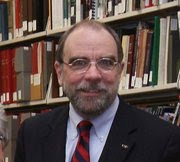"Virtual Cleveland"
In 1996 I attended a conference in Washington D.C. about providing governmental information over the Internet (using a technology other than the then-new World Wide Web!). When I returned to Cleveland, I began looking up people who'd I'd been told were up on this technology and that led me to a civil engineer in Bay Village, Soren Hansen. We struck up an email correspondence that resulted in over a hundred messages each way before we ever met.What got us so prolific in our correspondence was the idea we hatched about using the Web to provide access to information about the history of Cleveland and where this could conceivably wind up going someday. We were both enthusiasts of a technology called Geographic Information Systems (GIS) and our vision centered on an on-line, 3D version of a GIS we called "Virtual Cleveland." Virtual Cleveland would allow people to view the city at any point in its history, touring the streets and buildings to see what the city looked like in those days. Each such street and building would be rendered in 3D as a CADD (Computer Assisted Design and Drawing) drawing, built up from a GIS foundation. A GIS is an analytical tool for locating objects in precise locations and performing sophisticated research. This would mean that each object in the virtual model of the city would be scaled accurately and fully connected to all the data about it. Not only could you amuse yourself, touring this virtual environment and examining the city from every angle, but you could also analyze facts about the city, comparing population migrations against housing construction in 1967, for example, or the spread of the streetcar tracks during the nineteenth century. All manner of users could be accommodated, from the academic to the recreational. Historic preservationists could view an earlier representation of a building they were restoring, to see what the features were in those days, while a teenager could drive a virtual tank down Superior Avenue and blow holes in the Old Arcade.
We envisioned the information being inputted by a host of people, connected over the Web and governed by common protocols and standards. It would be a highly-distributed product, existing on no single server. Indeed, the core of Virtual Cleveland would be a network of servers, most of which would be furnishing real-time data from the operations of the government agencies, private corporations and others who, for various reasons, wanted to share some degree of information to achieve their objects or satisfy Public Access laws. People could explore today's Cleveland from afar, checking out potential land purchases, building rentals, convention facilities, sports arenas, and other economic facts. The water, sewer, police, zoning, and other governmental departments would provide basic levels of information (consistent with needs for security), so that a developer could determine what infrastructure was available to sites under consideration. The GCRTA would manage their rapid transit trains in this environment and, in short, the daily operations of the city would be inter-connected in ways that are bound to create synergies unimagined today. It certainly would put Cleveland "on the map" insofar as innovative uses of technology are concerned and would undoubtedly result in economic benefits in both operational savings and new jobs and industries attracted to his platform.
Labels: Cleveland history, GIS, virtual reality, Web


<< Home